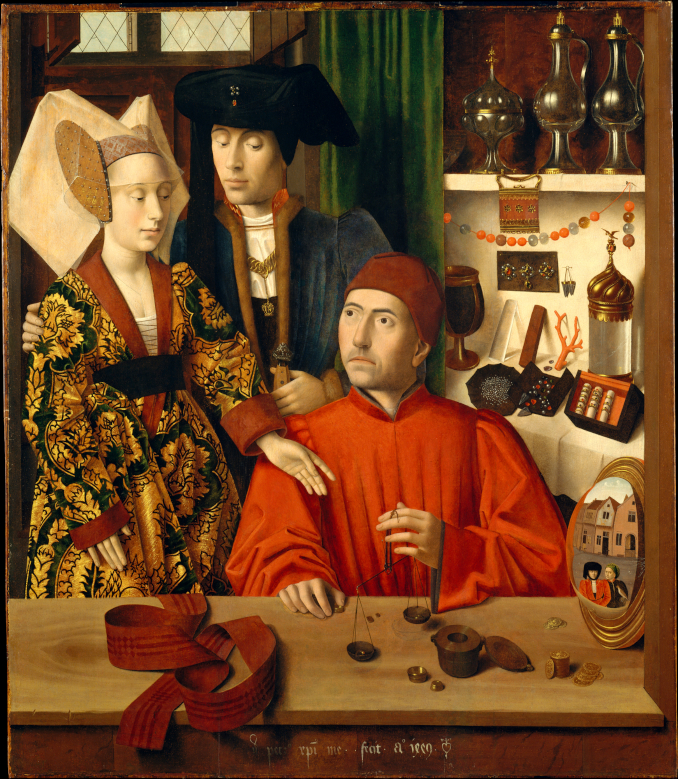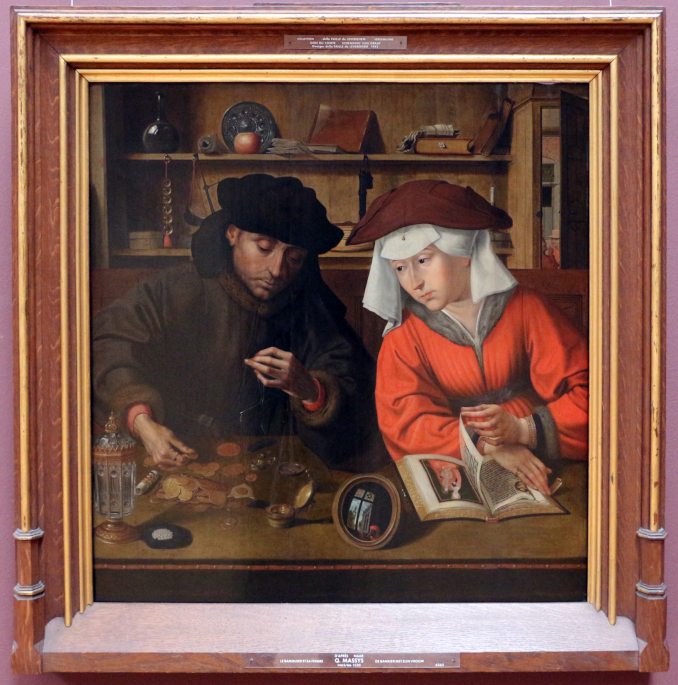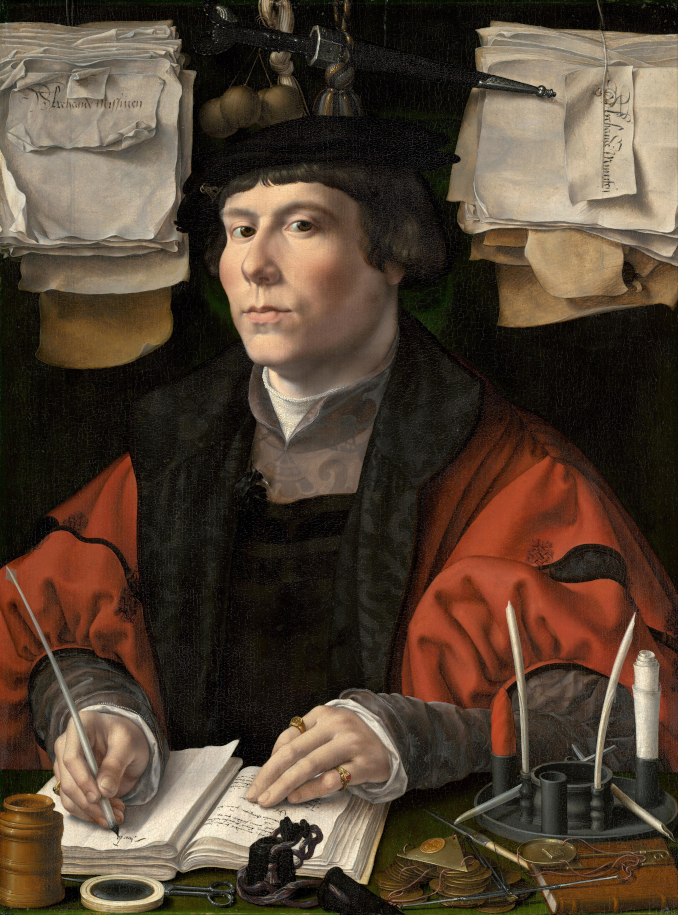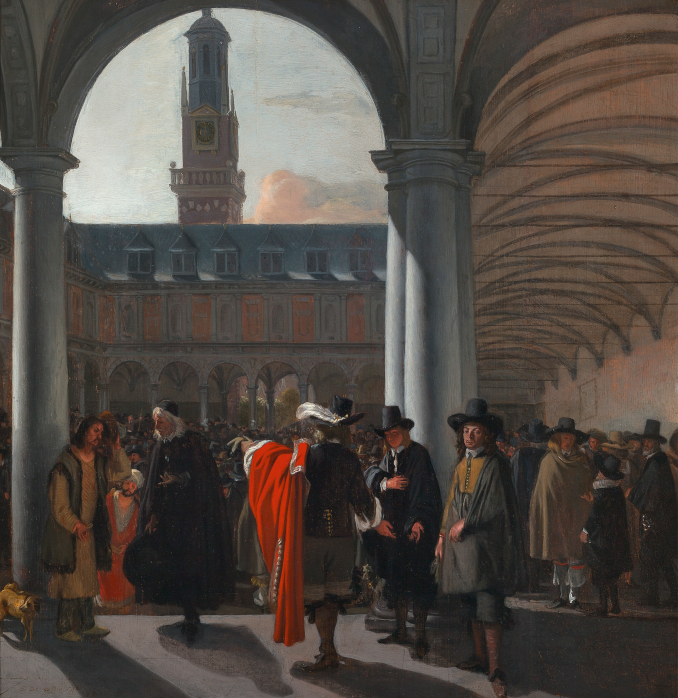
The Payment of Dues. Georges de la Tour, 1630-35. Lviv Art Gallery, Ukraine (until 1940 – Lwów Art Gallery, Poland), ex Lubomirski collection. Photo: Public domain via Wikimedia Commons.
By Nina Heyn – Your Culture Scout
Ever since precious metal coins were invented as a convenient alternative to barter, from Phoenicia to ancient China, they have become a preferred way of paying for goods. In 1828, an eighteen-year-old hunter on a shooting trip in the English countryside of Hampshire discovered a hoard of about a hundred gold coins. These beautiful gold thrymas (shillings) are now displayed in the Ashmolean Museum in Oxford, which acquired the so-called “Crondall Hoard” in 1944. The coins date to about AD 650. It is estimated that, according to the laws of the time, the value of these hundred gold pieces would have represented the compensation for killing a man.
Gold has always been a precious metal of choice, not only as currency but also as jewelry, especially for special occasions. There is a charming representation of a goldsmith and his clients in a 15th-century painting, which, for a long time, was thought to be a picture of St. Eligius, a patron of goldsmiths; later, the halo over his head was discovered to be a 19th-century addition. The carefully rendered face of the goldsmith is now considered to be a portrait of a real jewelry maker, Willem van Vleuten, a Flemish goldsmith who worked for Philip the Good, Duke of Burgundy, and who was commissioned to create adornments for the 1449 marriage of his niece Mary Guelders to James II, the King of Scots. In the painting, the shelves of this artisan are stocked with his glittery creations, and there is a stack of gold coins on the table—perhaps as currency or even as precious metal for future wedding bands.

A Goldsmith in His Shop. Petrus Christus, 1449. Metropolitan Museum of Art. Photo: Public domain via Wikimedia Commons.
In the medieval and Renaissance eras, paintings were mostly devoted to portraits of patrons, religious and mythological scenes, and images of nature. Less often, they would represent something to do with the mundane subject of money. However, this changed in the 16th and 17th centuries. The merchant social class started flourishing, and after the Reformation in central and northern Europe, when artists lost their church commissions, they began focusing on more secular topics. The art world thus gained countless representations of ordinary life at all levels of society. Images of coins as symbols of a sitter's profession or as a commentary on societal changes started to crop up in paintings, both commissioned and allegorical.
A perfect example of such a painting is a very famous canvas from the Louvre—The Money Lender and His Wife—painted in the early 16th century by Quentin Matsys (also called Massys). Matsys spent a large portion of his life in the port of Antwerp—a city that became a center of trade routes and political activities for refugees from both the Spanish Inquisition and the Reformation movements in the north. All this commerce and movement required banking activities, and this is a portrait of a couple whose family business is exactly that: money lending. The attributes of this profession are right there: coins, scales (to determine the value of metal in the coins), and some pearls that would be a perfect portable currency as well. The wife is ostensibly reading a religious book, but she is really leaning toward her husband, who is weighing the coins with utmost concentration. Business is obviously good: You can see some people, perhaps customers, visible through an open window and as a reflection in the mirror. There is also a calm balance—both the commercial and the religious activities of the couple are taking place at the same time in perfect harmony. This painting was much admired, copied, and referred to in later art.

The Money Lender and His Wife. Quentin Matsys, 1514. The Louvre. Photo: Public domain via Wikimedia Commons.
Another great painting that prominently displays coins is Portrait of a Merchant, the 16th-century painting attributed by most historians to Jan Gossaert, also known as Jan Mabuse. Gossaert was a court painter, a well-traveled artist who brought the Italian Renaissance to northern countries. The portrait includes, in great detail, the accoutrements of this merchant's profession: paperwork (presumably receipts, IOUs, and bills of sale), as well as his writing instruments and coins—mainly bronze or copper ones, but a gold one, too. The man's lips are pursed in concentration or maybe in disapproval at being interrupted at his paperwork.

Portrait of a Merchant. Jan Gossaert (attributed), circa 1530. National Gallery of Art, Washington. Photo: Public domain via Wikimedia Commons.
Carrying coins, especially the gold ones, over great distances and unsafe roads has never been the best idea, and definitely was not a practical solution in international commerce. Already, the Knights Templar in the Middle Ages used letters of credit to facilitate long-distance transactions. By the early 17th century, the Dutch Republic—a land thriving on international trade—had established the first formal stock exchange in Amsterdam.
Emanuel de Witte, a very talented painter of interiors, immortalized that historical first in The Courtyard of the Amsterdam Stock Exchange. De Witte's own life was a string of disasters; his second wife was arrested for theft together with his daughter, he fell into indenture for gambling debts, and when he finally tried to hang himself, the rope broke and he froze to death in a river. His art, however, is another matter—he was a master of perspective, painting elegant church interiors full of soaring architectural details. The Courtyard features a virtuoso rendering of vaulted ceiling ribs, an architectural element probably more interesting to this painter than the actual activities of the people inside. For us, it is a great portrait of what replaced investments in ancient gold hoards like the one at Crondall.

The Courtyard of the Amsterdam Stock Exchange. Emanuel de Witte, 1653. Museum Boysman van Beuningen, Rotterdam. Photo: Public domain via Wikimedia Commons.
Last but not least, take a look at one of the most celebrated portraitists of all time. Hans Holbein the Younger was a German artist who could not make a living in his native Augsburg or in his later workshop in Basel but who was a riotous success as the court painter of Henry the VIII, creating better-than-life images of both the despot king and his unfortunate wives. In London, he lived among his countrymen in an area called Steelyard, which was a harbor community of expatriate German merchants. There he painted a portrait of a prominent trader from Danzig (today's Gdańsk on the Polish coast). Apart from a naturalistic psychological portrait of the sitter, the composition is full of symbolic signals. The table is covered with a rich Persian carpet, and coins, seals, red wax, and receipts attest to the sitter's professional status. There is, however, a glass vase precariously perched on the edge of the table. In the same way that a vase can fall and break at any minute, the implication is that a trader's contented and affluent existence can end at any minute—perhaps through financial ruin, perhaps due to plague or a royal disfavor. Holbein, who witnessed all kinds of misfortunes—some of them decreed on a whim by his royal master—would have been very aware that status and wealth do not guarantee everything in life.

The Merchant Georg Gisze. Hans Holbein the Younger, 1532. Berlin State Museum. Photo: Public domain via Wikimedia Commons.
Generally in art, anything to do with money is invisible—more connected to the value of the paintings than to overt displays on canvas—but sometimes, as in the old masters' works above, you can catch a glimpse of physical currencies and the people who traded them.
